Spruce glauka globoza on a trunk planting in the fall. Spruce prickly glauka globoza on a trunk
Description
Fir-tree prickly Glauka Globoza (Picea pungens Glauca globosa) - dwarf form. Height up to 2-3 m, crown diameter up to 2 m.Annual growth of 8 cm per year in height and 10 cm in width. In a young plant, the crown is loose and irregular cushion-shaped, later it begins to grow upward, becomes wide-conical or spherical, very dense. The needles are prickly, thick 1-1.5 cm, bright silver-blue color. Cones elongated shape, Brown hanging. Cones ripen and fall in the first year. Undemanding to soils. Frost resistant. The prickly spruce "Glauca globosa" survives up to 500 years. Sufficiently drought-resistant, resistant to smoke, gas, dust and soot.
| Trunk and shoots: | Dwarf shirokokonicheskiy variety of spruce prickly. The crown of the first years of life has a slightly flattened spherical crown, without a clearly defined trunk. With age, the main trunk is formed in most specimens and by the age of 30 they can rise up to 2-3 m. In this case, the crown can be both symmetrical and asymmetric. |
| Needles / Foliage: | The needles are densely located on the shoots, silvery-blue, bright, very prickly, not completely radial, slightly crescent-shaped, about 1 cm long. |
| Fruit: | Cones are elongated, brown, hanging. Ripen and fall off in the first year. |
| Soil requirements: | Has low soil and moisture requirements. It grows even on sandy soils, but prefers fertile, moist, drained, acidic or slightly acidic environment (see). |
| Photophilousness: | Fir-tree prickly Glauka Globoza photophilous. |
| Drought resistance: | Sufficiently drought-resistant. |
| Frost resistance: | Winter hardiness. USDA zone 2 (see). |
| General adaptability: | Resistant to smoke, gas, dust and soot. |
| Purpose: | Colorado spruce "Glauca globosa" is a very popular variety of prickly spruce in small gardens, for single and group plantings on the lawn and rock gardens. Also used for urban plantings. |
Planting and caring for prickly spruce Glauka Globoza
Do not allow soil compaction and moisture stagnation. The landing site should be away from groundwater. It is imperative to make a drainage layer, in the form of sand or broken brick 15-20 cm thick.If spruces are planted in groups, then the distance for tall spruces should be from 2 to 3 m. Depth landing pit 50-70cm.
It is important that the root collar is at ground level. You can prepare a special potting soil: leaf and sod land, peat, and sand in a ratio of 2: 2: 1: 1. Immediately after planting, the tree must be watered abundantly with 40-50 liters of water. It is advisable to add fertilizer (100-150 g of nitroammofoska, root 10 g per 10 l, etc.).
Ate does not like dry hot weather, so in the hot season they need to be watered once a week, about 10-12 liters per tree. Shallow loosening (5cm). For the winter, sprinkle peat around the trunk with a thickness of 5-6 cm, after winter, the peat is simply mixed with the ground, not removed. Ate can also be planted in winter.
Fertilizer for conifers can be applied about 2 times a season.
Usually spruce does not need pruning, but if they form hedge pruning is allowed. As a rule, diseased and dry branches are removed. It is best to carry out pruning in late May - early June, when the period of active sap flow ends.
To protect decorative forms of spruce from autumn and winter frosts, they can be covered with spruce branches. (cm. , ).
If you are a professional gardener or at least just a lover of garden art, then your garden must have conifers... Even on the most ordinary garden plot a coniferous bush or tree will bring species diversity, attract attention and create a “forest” atmosphere, releasing useful phytoncides into the air.
Maybe you are content with the simplest conifers from the forest - spruce, pine, common juniper? But a huge assortment of conifers with different colors of needles and crown shapes in nurseries can take your breath away and fill you with the desire to create unique, fabulous compositions in your garden.
 Enough to get to know by EcoPlant nursery where a riot of colors and shapes of conifers will give you the opportunity to make your dream come true - to create the most beautiful place in the garden for relaxation.
Enough to get to know by EcoPlant nursery where a riot of colors and shapes of conifers will give you the opportunity to make your dream come true - to create the most beautiful place in the garden for relaxation.
Moreover, the plants from the nursery take root better and grow faster! Enough go to the website of the cattery through the banners in the upper right corner of the page, and you will find yourself in the kingdom of evergreens.  So, Are you ready to experiment and create coniferous compositions in landscape design
with your own hands? Then go ahead!
So, Are you ready to experiment and create coniferous compositions in landscape design
with your own hands? Then go ahead!
Coniferous compositions in landscape design from giants deserve attention. Still would! They are multifunctional.
- Birds can nest on tall trees without fear of being hunted by domestic animals. And birds, as you know, are garden healers. They eat small pests of plants, they revive the garden with their chirping.
- Coniferous large-sized trees create a pleasant shade in the garden, where you can place a gazebo or bench for relaxation.
- These giants protect the site from winds and drafts, noise and dust from the street is lost in their dense crown.
 From large coniferous trees, you can collect a lot of cones, needles, and use in cosmetology, for medicinal purposes. Well, who would not like to soak up the bathroom with fragrant pine needles, or try the healing cone jam right now?
From large coniferous trees, you can collect a lot of cones, needles, and use in cosmetology, for medicinal purposes. Well, who would not like to soak up the bathroom with fragrant pine needles, or try the healing cone jam right now?
Where to plant a tall coniferous tree on the site?
It depends on which area is in size. If the garden is large, plant the giant in an open area, giving it plenty of space. When you can look at a tree from afar without throwing your head back, then all its greatness and beauty is revealed ...
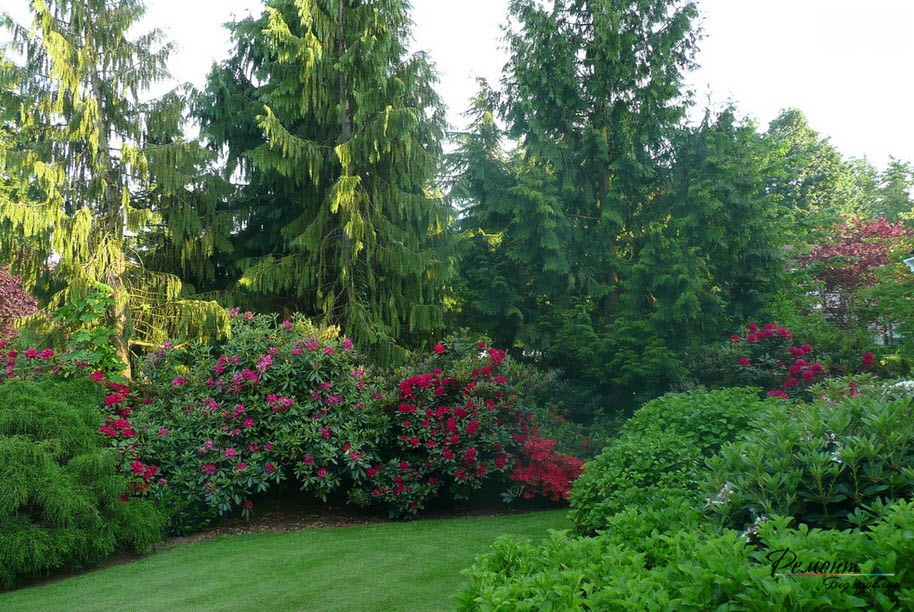 But if the site is small, then a large coniferous tree can serve as a background for undersized plants... Choose slow-growing plants for your coniferous composition in your landscaping.
But if the site is small, then a large coniferous tree can serve as a background for undersized plants... Choose slow-growing plants for your coniferous composition in your landscaping.
And if you also cut them, then they will be more compact, lush. Rest assured that New Year's holidays will be held near this coniferous giant, with barbecue and hot drinks!
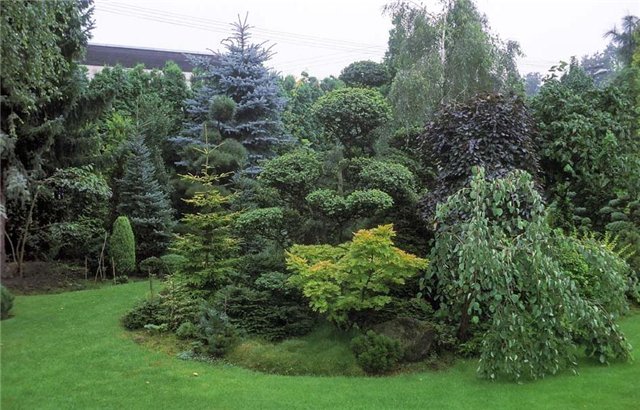 What coniferous large-sized trees to plant on the site?
What coniferous large-sized trees to plant on the site?
Now spruce spruce is in great demand "Hoopsie", European cedar pine, western thuja "Brabant" and "Aureospicata", single-colored fir, etc.
For example, Scots pine "Vaterery" with beautiful blue-gray needles, it is convenient for a small garden because it is slow-growing. By the age of 30, it grows only 3 m. In height and 3 m. In diameter! At the bottom, her crown is not exposed, which allows you to create coniferous compositions from it in landscape design in the form of living screens, green hedges.
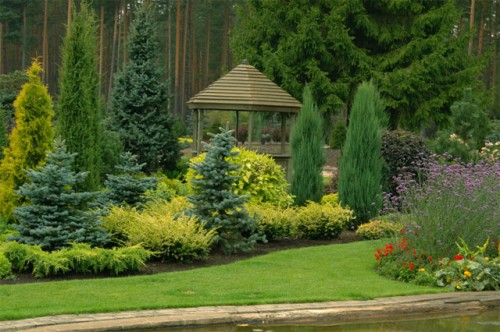 Up to 10 years old, your garden will be decorated with two-meter thuja, for example, varieties "Emerald"... And then they will grow up to 4 meters - near the entrance to the site or to the house, they look like green guards!
Up to 10 years old, your garden will be decorated with two-meter thuja, for example, varieties "Emerald"... And then they will grow up to 4 meters - near the entrance to the site or to the house, they look like green guards!
If a large pine or spruce is planted in the wrong place, then restrain growth with a cardinal haircut. Each year it is necessary to cut the lateral, and especially the apical young shoots.
But thujas and junipers are enough to make a "cosmetic" haircut, remove prominent and crooked shoots. But usually this is a rarity, and such plants do just fine without the intervention of "gluttonous" scissors. 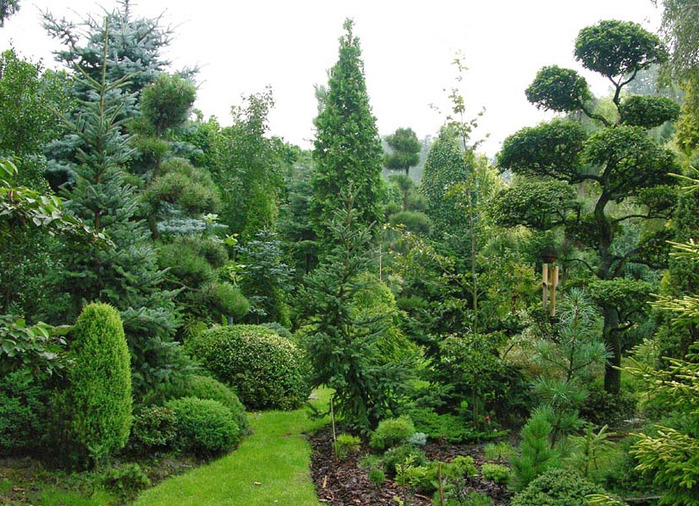 "Medium" coniferous compositions in landscape design.
"Medium" coniferous compositions in landscape design.
Recently, there are so many species, forms and varieties of small, compact, medium-sized conifers that your eyes run up and your hands stretch!
Such beautiful western thuja with a crown in the form of a ball or cone, small pines and spruces with colored needles, junipers, firs, pea cypress trees, Canadian hemlock! And all of them can be different, that you can make up coniferous compositions in landscape design from just one species, but from different varieties!
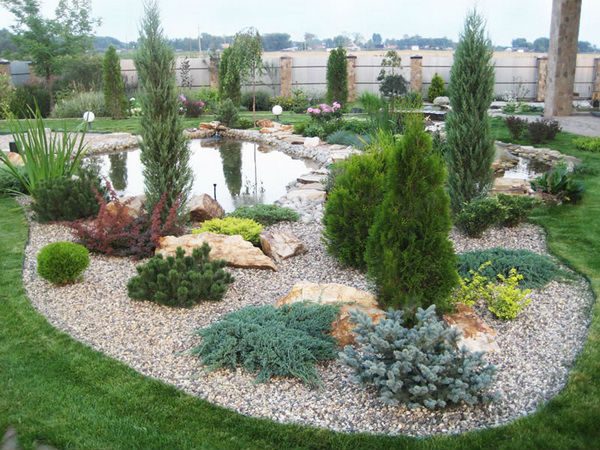 These are the most popular plants, because you can create coniferous compositions from them both in a large garden and on an ordinary six hundred square meters. It is the medium-sized conifers that adorn mixborders, mixed flower beds, winter compositions, heather and stone gardens.
These are the most popular plants, because you can create coniferous compositions from them both in a large garden and on an ordinary six hundred square meters. It is the medium-sized conifers that adorn mixborders, mixed flower beds, winter compositions, heather and stone gardens.
For example, it is very beautiful to plant spherical thuja varieties "Globoza" on the sides of the path, or near the very entrance to the house. Mountain pine looks interesting along the fence. Moreover, depending on the height of the fence, you can choose pine varieties of different heights - "Mugus", "Pomilo", "Gnome", "Pug".
In any coniferous compositions, a prickly spruce can become an accent. "Glauka Globoza" with its blue needles.
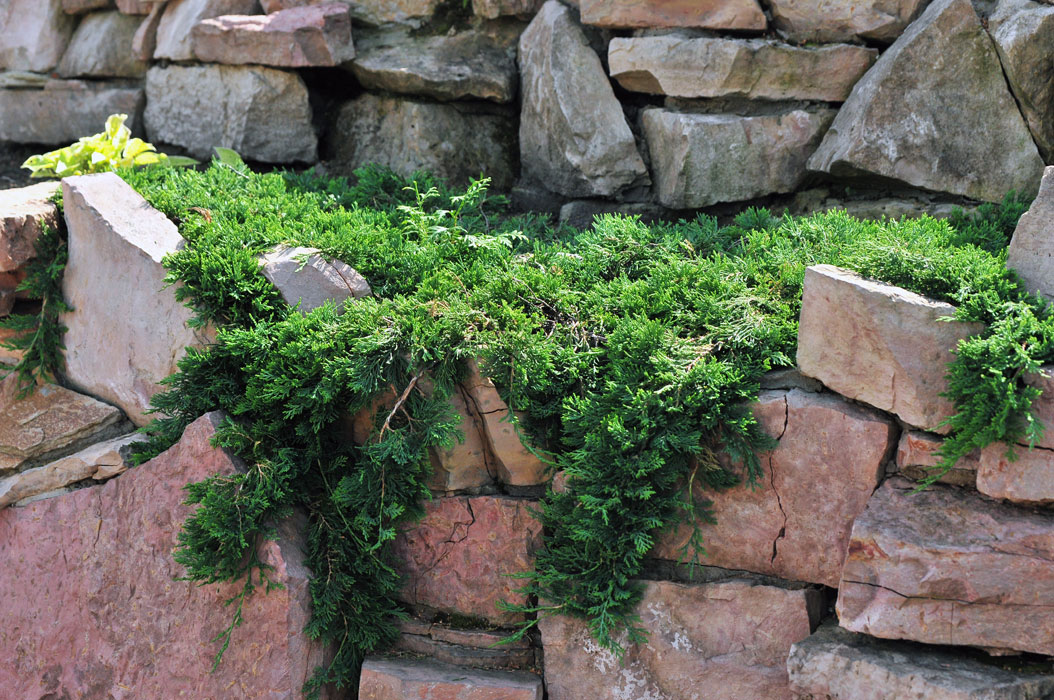 Coniferous compositions from creeping bushes.
Coniferous compositions from creeping bushes.
Now it is fashionable to create such compositions where not only tall, cylindrical or conical species and varieties can prevail, but also creeping conifers covering stones and driftwood. They look great in large gardens, rock gardens, rockeries, rutaria, Japanese gardens, retaining walls.
Let's single out the most popular ones, some of them can grow only a few centimeters in height! These are varieties of horizontal junipers - Blue Chip, Golden Carpet, Prince of Wales... And common junipers "Depressa Aurea", "Green Carpet".
The shortest conifers are often planted in clumps or instead of a lawn.
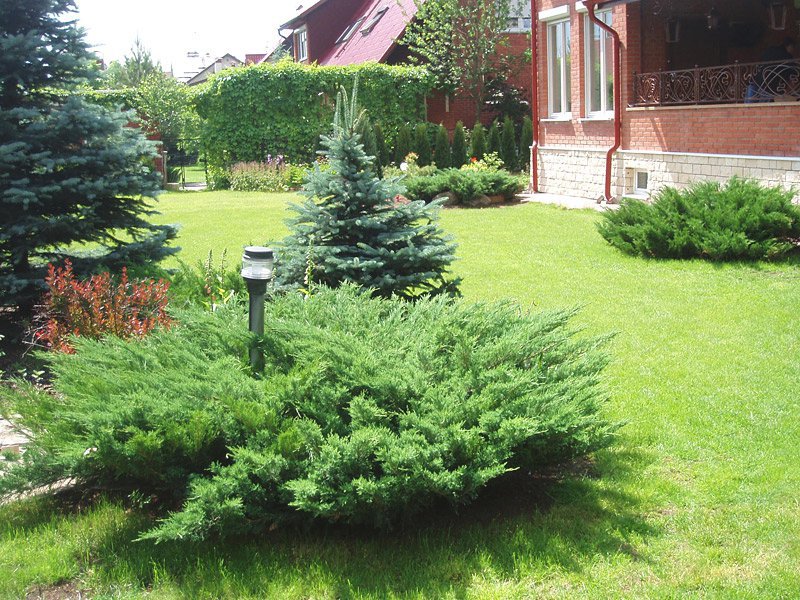 If you are interested in higher "carpets" made of conifers, then pay attention to the middle juniper "Old Gold", scaly juniper "Blue Carpet", cross-pair microbiota.
If you are interested in higher "carpets" made of conifers, then pay attention to the middle juniper "Old Gold", scaly juniper "Blue Carpet", cross-pair microbiota.
But the Cossack junipers "Glauka" and middle "Mint Julep" at a low height, they have a wide, spreading crown.
Creeping varieties are also found in other types of conifers. For example, ordinary sleepyhead Hillside Creeper, Norway spruce "Formanek", Canadian hemlock "Prostrata", mountain pine Jacobsen.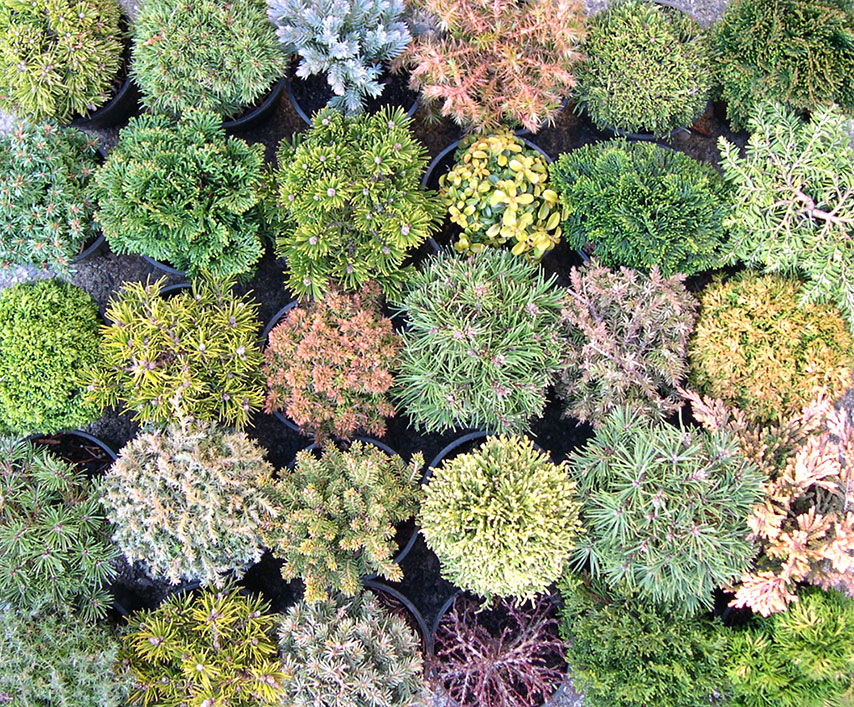 Coniferous compositions in landscape design from dwarf representatives. This is truly a miracle in the garden kingdom. Miniature, neat, lush, various dwarf conifers should definitely decorate any coniferous composition... The simplest alpine slide or rockeries will become much more noticeable, more natural.
Coniferous compositions in landscape design from dwarf representatives. This is truly a miracle in the garden kingdom. Miniature, neat, lush, various dwarf conifers should definitely decorate any coniferous composition... The simplest alpine slide or rockeries will become much more noticeable, more natural.
Description
Picea pungens "Glauca Globosa"
Glauka Globoza- dwarf variety ate prickly.It grows so slowly that at the age of 30 it reaches only one and a half meters. Shoots are short, tough.
Young Picea pungens Glauca globosa has the shape of a flattened ball, and mature tree acquires a wide-conical shape. The color of the needles is silvery-blue, young shoots are brighter in color.
Features of care spruce prickly Glauka Globoza
Glauca globosa frost-resistant, but in the first year or two after planting, you should take care of the spring shelter from direct sunlight, otherwise the seedling may suffer from burns.
The Christmas tree is not demanding on the soil, but, like all spruces, it does not tolerate stagnant waterlogging of the soil. For a comfortable fit, a drainage layer of gravel and sand should be provided. It is recommended to mulch the trunk circle with peat, mown grass or wood chips. Mulch will preserve the moisture and looseness of the soil, and when rotting, it will gradually supply the tree with organic fertilizers.
Spruce Glauka Globoza- the variety is very popular and is often used in landscape design of both large and small gardens. Such an original blue spruce cushion is good on the lawn as a specimen, in a group with other plants and as a container crop. The standard form deserves special praise ate Glauca Globosa... Such an original blue ball is appropriate in any corner of your beautiful garden.
Life form: Conifer tree or bush
Crohn: Spherical or broadly conical, dense.
Growth rate: Slow. Annual growth is 10 cm in height and 10 cm in spread.
Height 2 m., Crown diameter 3 m.
Durability: 600 years
Fruits: Cones, elongated, brown, 5 to 10 cm.
Needles: Needle-like, hard, silvery blue.
Decorative: Spruce prickly "Glauka Globoza" has a beautiful crown shape and color of needles.
Usage: Single plantings, decorative groups.
Growing conditions
to light: shade-tolerant
to moisture: drought-resistant
to soil: not picky
to temperature: frost-resistant
Homeland: Japan
Planting and leaving
Landing features:
Grows best in shaded areas. On fertile soil, spruces form deeper roots.
Root overdrying should be avoided when transplanting. Afraid of trampling and soil compaction. Does not tolerate close groundwater. If the groundwater is close, drainage is necessary, consisting of crushed stone with a layer of 10-20 cm. The root collar is at ground level.
Norway spruce prefers loamy and sandy loam soils.
Soil mix:
Sod land, peat, sand - 2: 1: 1.
Optimal acidity - pH 4 - 5.5
Top dressing:
When planting, nitroammofoska is introduced (100 g).
Watering:
Demanding on soil moisture, poorly tolerates drought.
It is obligatory to water young plants in a hot dry summer (once a week, 1-1.5 buckets for each plant).
Colorado spruce tolerates soil dryness longer than Norway spruce.
Young plants during dry periods require more frequent and abundant watering.
Loosening:
Shallow, 5-7 cm under young plantings.
Mulching:
Peat with a layer of 5-6 cm. Subsequently, the peat is not removed, but mixed with the ground.
Cropping:
When using spruce trees in hedges, radical pruning is possible. Usually, only dry and diseased branches are removed.
Pests:
Spruce-larch hermes
Spruce bast leaf roll
Diseases:
Preparing for winter:
Adult plants are quite winter-hardy. However, the needles of young seedlings of some decorative forms of spruce should be protected from early spring and late autumn frosts.
Adults ate ate no protection for the winter.
It is a common species among conifers. The variety was bred in 1937. It appeared on sale in the middle of the 20th century and began to be actively used for cultivation in Europe.
Decorativeness.
Glauka Globoza is evergreen ornamental plant... Differs in small growth, rounded crown and silvery-blue color of needles. At the beginning of life, the spruce has a slightly flattened loose crown in the form of a ball. After 10-15 years, the spruce turns into a triangular beauty. It grows very slowly, the annual growth is 8-10 cm. After 30 years of existence, the spruce reaches 1.5-2 meters and does not grow anymore. Shoots are short, tough. Needle needles with pointed ends, densely located on the shoots. Cones are oblong, small, light brown. Glauca Clobosa lives for about 500 years. This kind prickly spruce considered popular, often used in landscape design, for growing in the garden, creating a mini-forest. Will become an unusual decoration of stone hills, flower beds... An original plant, an unusual shape will be appropriate in any corner suburban area... Can also be grown in pots, balconies and rooftops.
Colorado spruce Glauca Globosa planting and care.
The landing site should be far from groundwater. To prevent stagnation of water, before planting, it is necessary to make drainage from fine gravel or small pebbles. When planting seedlings in groups, the distance from each other should be 3 meters. Glauka Globoza prefers loose, humus-rich soil, grows well on black soil. Young spruces, during the first years after planting, can be sprinkled with peat and grass to protect them from frost and strong winds. Mulching is also used to slowly evaporate moisture. After planting, trees should be watered with plenty of water and fertilizer. Adults ate frost-hardy, but do not like drought. In hot weather, about 1-2 times a week, trees need to be watered and loosened. Due to its slow growth, there is no need to shape the tree and trim it. Sometimes carried out sanitary pruning, during which dry, broken branches are removed. Glauca Clobosa is resistant to poor environmental conditions. Colorado spruce is vulnerable to aphids, spider mites, leaf rollers, bark beetles. Having missed the moment, the plant can become very sick, at best, a special medicine can cope with the misfortune, and in worst plant may die. The most important point of caring for ornamental spruce is regular prophylaxis against pests and diseases.
Sale Colorado spruce Glauca Globosa also carried out on our website.
Description
Picea pungens "Glauca Globosa"
Spruce prickly Glauka Globoza- a dwarf variety of prickly spruce.
It grows so slowly that at the age of 30 it reaches only one and a half meters. Shoots are short, tough.
Young Picea pungens Glauca globosa has the shape of a flattened ball, and an adult tree acquires a wide conical shape. The color of the needles is silvery-blue, young shoots are brighter in color.
Features of care spruce prickly Glauka Globoza
Glauca globosa frost-resistant, but in the first year or two after planting, you should take care of the spring shelter from direct sunlight, otherwise the seedling may suffer from burns.
The Christmas tree is not demanding on the soil, but, like all spruces, it does not tolerate stagnant waterlogging of the soil. For a comfortable fit, a drainage layer of gravel and sand should be provided. It is recommended to mulch the trunk circle with peat, mown grass or wood chips. Mulch will preserve the moisture and looseness of the soil, and when rotting, it will gradually supply the tree with organic fertilizers.
Spruce Glauka Globoza- the variety is very popular and is often used in landscape design of both large and small gardens. Such an original blue spruce cushion is good on the lawn as a specimen, in a group with other plants and as a container crop. The standard form deserves special praise ate Glauca Globosa... Such an original blue ball is appropriate in any corner of your beautiful garden.
Life Form: Coniferous tree or shrub
Crohn: Spherical or broadly conical, dense.
Growth rate: Slow. Annual growth is 10 cm in height and 10 cm in spread.
Height 2 m., Crown diameter 3 m.
Durability: 600 years
Fruits: Cones, elongated, brown, 5 to 10 cm.
Needles: Needle-like, hard, silvery blue.
Decorative: Spruce prickly "Glauka Globoza" has a beautiful crown shape and color of needles.
Usage: Single plantings, decorative groups.
Growing conditions
to light: shade-tolerant
to moisture: drought-resistant
to soil: not picky
to temperature: frost-resistant
Homeland: Japan
Planting and leaving
Landing features:
Grows best in shaded areas. On fertile soil, spruces form deeper roots.
Root overdrying should be avoided when transplanting. Afraid of trampling and soil compaction. Does not tolerate close groundwater. If the groundwater is close, drainage is necessary, consisting of crushed stone with a layer of 10-20 cm. The root collar is at ground level.
Norway spruce prefers loamy and sandy loam soils.
Soil mix:
Sod land, peat, sand - 2: 1: 1.
Optimal acidity - pH 4 - 5.5
Top dressing:
When planting, nitroammofoska is introduced (100 g).
Watering:
Demanding on soil moisture, poorly tolerates drought.
It is obligatory to water young plants in a hot dry summer (once a week, 1-1.5 buckets for each plant).
Colorado spruce tolerates soil dryness longer than Norway spruce.
Young plants during dry periods require more frequent and abundant watering.
Loosening:
Shallow, 5-7 cm under young plantings.
Mulching:
Peat with a layer of 5-6 cm. Subsequently, the peat is not removed, but mixed with the ground.
Cropping:
When using spruce trees in hedges, radical pruning is possible. Usually, only dry and diseased branches are removed.